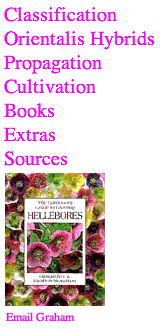

Here I follow Brian Mathew's classification and nomenclature as described in detail in his indispensable monograph, now out of print. However it’s becoming clear that more time and observation is needed before the species can be fully understood for although Brian's book sets out a clear and practical approach, when plants are examined in the wild there always seem to be contradictions. This is partly because some of the species are simply so variable, partly because of natural hybridisation.
Problems arise for gardeners when individual plants vary from one season to the next and individuals of the same clone seem slightly different in the same season. In particular the degree of hairiness present on emerging leaves and stems may vary, also the colour of the new leaves and even the colour of the flowers.
Opinions are evolving; Brian Mathew and Will McLewin have recently described their new species, H. croaticus, but to many gardeners the distinctions between this and related species remain unconvincing. However, rather than discuss possible changes to Brian's classification so we have simply followed his scheme.